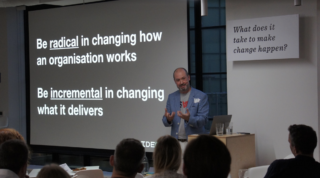
Earlier this week, some of the Public Digital team attended the Make Change Happen event at IDEO’s London office. You may have seen Ben’s post from yesterday, spelling out our close relationship with IDEO.
While we were there, I did a very short talk about something that’s been on my mind in recent months: architectural innovation, and how it applies to the sort of problems our clients have, and the sort of work we do for them.
“Architectural innovation” is a term coined by a pair of academics, Rebecca Henderson and Kim Clark, back in the 1990s. They wrote a paper about it which you can read for free on JStor, and which was referenced more recently in an FT article by Tim Harford.
You should read both of those, if you can, to get a proper understanding of what it’s all about. For now, I’ll give you the briefest of overviews.
One point about architectural innovation is the idea that you can change the nature of something (Henderson and Clark were talking about products) without changing any of the component parts, just the way they interconnect or interrelate.
Their simple example was a company making ceiling fans. For such a business, simple architectural innovation could mean starting to make desk fans, using mostly the same or very similar parts. It’s just the way those parts are configured that changes.
This is basically what we’ve been saying for years – to our clients at Public Digital, to our colleagues at the Co-op, and to ministers while we worked at GDS.
The most radical change we brought about in government was cultural and behavioural. We encouraged new ways of thinking, new agile ways of working, and new flexible team structures. In fact, we allowed teams to structure themselves in any way that suited them. We hired a bunch of new people but also gave hundreds of existing civil servants a newer, flatter hierarchy and a new set of tools, both physical and metaphorical. Our efforts were focused on changing the configuration of government. On radical change of how it worked.
But the outcomes and deliverables changed in a more incremental manner.
GOV.UK is built and run in a very different way to the hundreds of websites it replaced, but the actual delivery of information and services isn’t much different to Directgov, its predecessor. It’s incremental change in what gets delivered.

That was my core message at the IDEO event the other night, and what lies at the heart of Public Digital’s reason for being:
If you want to make transformation happen and make it stick, you need to be radical in changing how your organisation works, but incremental in changing what it delivers.
This is why we work with people who lead (like CEOs, ministers, presidents and prime ministers), to help them bring about the necessary radical org change; and with the people who deliver new products and services (teams, product leads, service managers), to help them deliver incremental change that meets user needs.
That’s our remit: radical org change, and incremental delivery change.
They’re our audience: presidents and practitioners.
It’s not about the technology or the marketing, it’s about service delivery and team culture.

4 thoughts on Radical org change, incremental delivery change
The end of business as usual – Public DigitalApril 6, 2020
[…] agility and experimentation – mental, cultural, legal and technical – are coming down. Mike has written about how if you want to make transformation stick, you need to be radical in changing how your […]
Remixing my Christmas interview on Radio 4 – Public DigitalJanuary 14, 2019
[…] ways of working, and granting the teams that work for them permission to work that way. That’s radical organisation change in […]
How to hire an internet-era CTO – Public DigitalOctober 19, 2018
[…] are unfamiliar (or even uncomfortable) for your organisation. It could easily be one of those “radical org change, incremental delivery change” moments. So here are a few things you can get started on right […]
We’ve partnered with IDEO – Public DigitalSeptember 28, 2018
[…] Last night a few of us attended an event at IDEO’s London office, to discuss what change really looks like and how organisations can make it happen. Mike gave a short talk, which he’ll tell you more about in another blog post tomorrow. […]